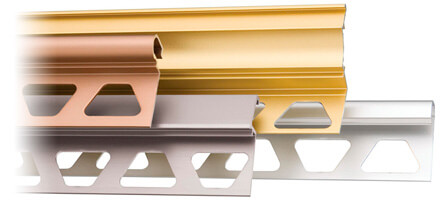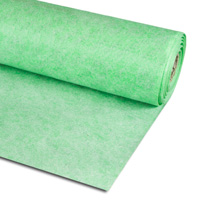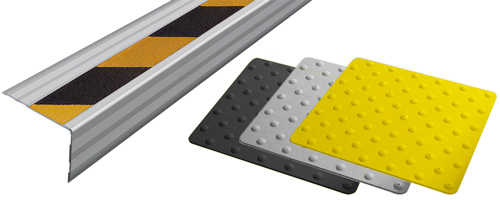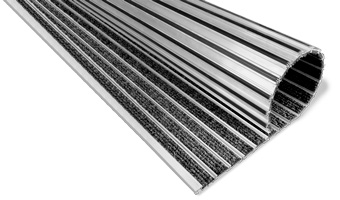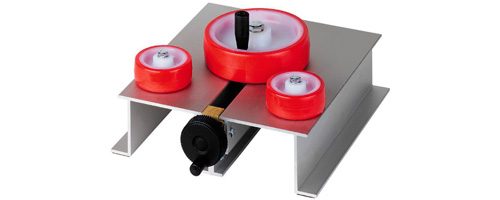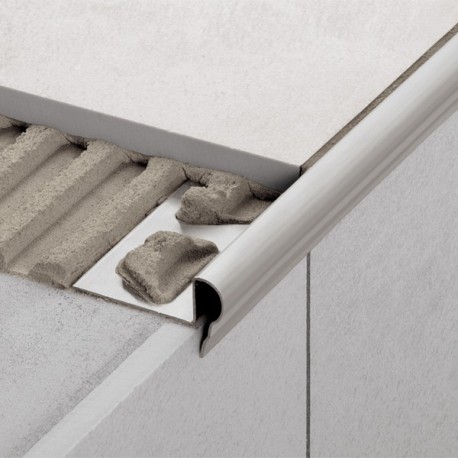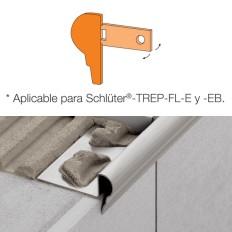Schlüter TREP-FL is an aluminium or stainless steel stair nosing profile in Florentine design for enhancing the safety and visual appeal of stair edges.
It is designed for installation in steps with tile or natural stone coverings. Schlüter TREP-FL is intended for use in residential or similarly used interior applications with low foot traffic. The profile is solidly embedded in the covering and cannot be replaced when it becomes worn (our stair-nosing profiles Schlüter TREP-S and -B as well as Schlüter TREP-G feature a replaceable tread).
Schlüter TREP-FL protects the front edge of steps and increases visibility providing a defined edge between the vertical and horizontal edge of the step, in support of safety on stairs. The aluminium profile has an additional slip resistant tread. Matching end caps are available as accessories.
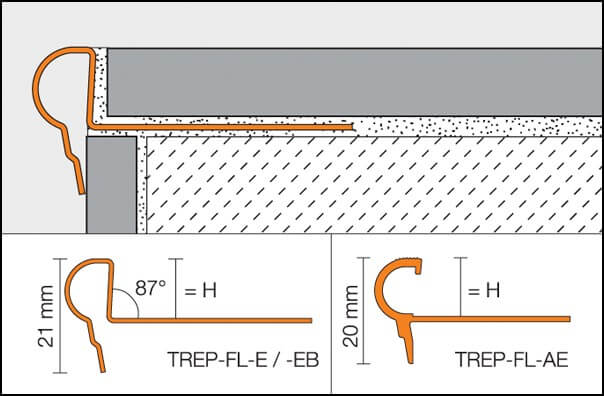
Material
The profile is available in the following finishes:
- E = stainless steel V2A (material no. 1.4301 = AISI 304)
- EB = brushed stainless steel
- AE = anodised aluminium
Material properties and areas of application
The suitability of a proposed type of profile must be verified based on the anticipated chemical, mechanical, and/or other stresses. Schlüter TREP-FL is intended for use in residential or similarly used interior applications with low foot traffic. The information provided below is intended as a general guideline.
Schlüter TREP-FL-AE, made of anodised aluminium, has an anodised surface finish that will not change under normal circumstances. The surface must be protected against abrasion or scratching.
Cementitious materials, in conjunction with moisture, become alkaline. Since aluminium is sensitive to alkaline substances, exposure to the alkali (depending on the concentration and duration of exposure) may result in corrosion (aluminium hydroxide formation). For this reason, remove mortar or grouting material immediately from all visible areas and do not cover freshly installed coverings with foil. In addition, ensure that the profile is solidly embedded in the setting material to prevent water from accumulating in small cavities.
Schlüter TREP-FL-E/-FL-EB is made of roll formed stainless steel V2A (material no. 1.4301). The profile structure therefore differs slightly from the appearance of the extruded aluminium versions.
Stainless steel is particularly well suited for applications that, in addition to heavy mechanical stresses, require resistance to chemicals such as acidic or alkaline detergents. Even stainless steel is not resistant to all chemical stresses, and may be affected by hydrochloric and hydrofluoric acid or certain chloride and brine concentrations. In certain cases, this also applies to seawater pools. Special anticipated stresses should therefore be verified in advance.
Installation
- Select Schlüter TREP-FL according to tile thickness.
- Set the covering material on the riser so that the top edge of the covering is at the correct height.
- Apply suitable tile adhesive along the edge area above the riser.
- Embed Schlüter TREP-FL fully in the tile adhesive and align the profile in such a way that the profile’s overhanging edge is flush with the riser tile after applying adhesive.
- In the case of Schlüter TREP-FL-AE, which is made of aluminium, the inner rounded cavity at the profile’s front edge must also be filled with suitable tile adhesive prior to installing the tiles.
- Completely cover the perforated anchoring leg and the tread area with tile adhesive.
- Firmly press the tread tile into place and adjust it in such a way that the tiled surface is flush with the top of the profile. All tiles in the profile area must be solidly bedded.
- A joint of approximately 2 mm should be left between the tile and the profile.
- Fill the joint completely with grout.
Maintenance
Schlüter TREP-FL requires no special maintenance or care. Damaged anodised surfaces can be restored with paint. Stainless steel surfaces exposed to the environment or aggressive substances should be cleaned periodically using a mild household cleaner. Regular cleaning maintains the neat appearance of stainless steel and reduces the risk of corrosion. All cleaning agents must be free of hydrochloric and hydrofluoric acid.
Avoid the contact with other metals, such as regular steel, to prevent corrosion. This also includes installation tools such as trowels or steel wool, e.g. for the removal of mortar residue. We recommend the use of the stainless steel cleaning polish Schlüter CLEAN-CP.

